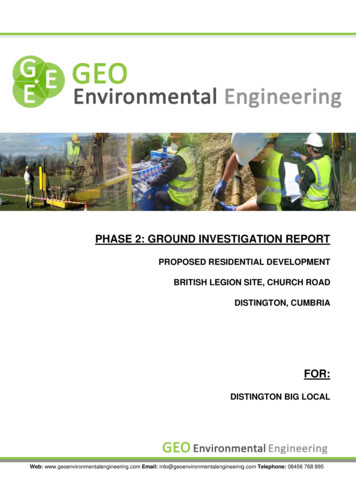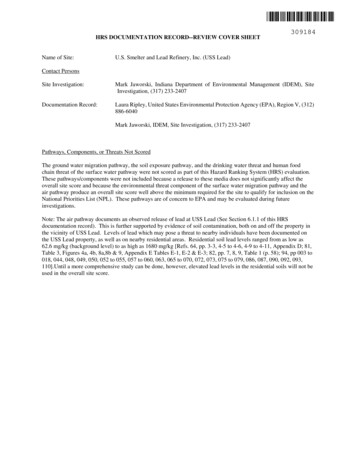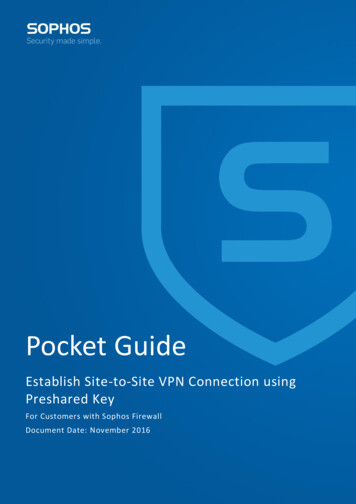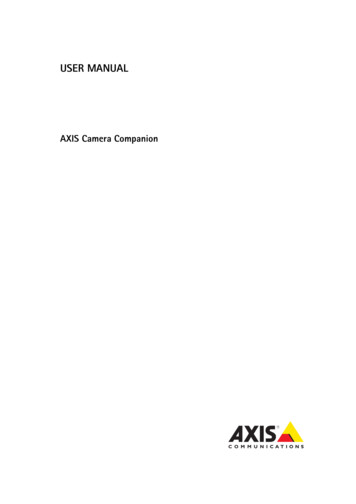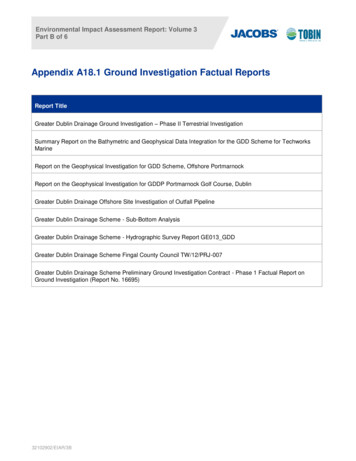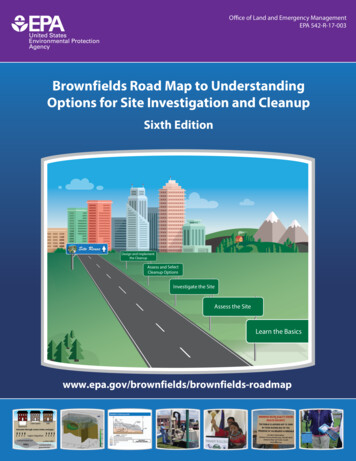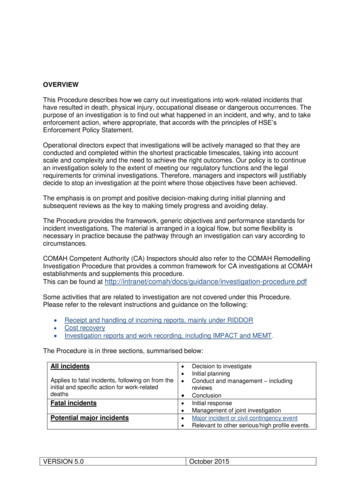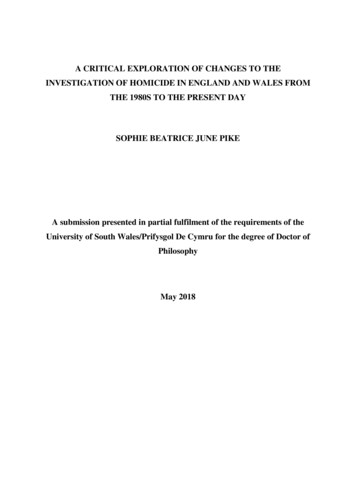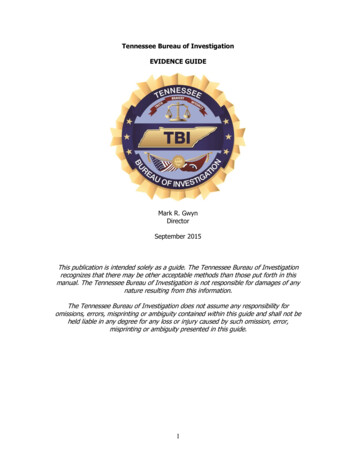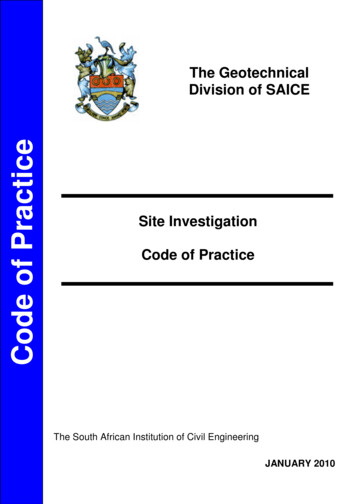
Transcription
Code of PracticeThe GeotechnicalDivision of SAICESite InvestigationCode of PracticeThe South African Institution of Civil EngineeringJANUARY 2010
iiPREFACEThe Site Investigation Code of Practice establishes a standard of "acceptable engineeringpractice" to assist the construction industry (client, project manager, consultant, contractor) inthe planning, design and execution of geotechnical site investigations in southern Africa.PREFACEThe code has been introduced to the South African civil engineering industry to addressshortcomings that have lead to inappropriate investigations being carried out. The code ispublished as a guide to good practice and is not intended to be prescriptive in its content andrecommendations. The recommendations contained herein are based on generally acceptednational and international standards and principals, and any deviation from theserecommendations should be defended by sound engineering judgement or site specificexperience.Site investigation is a complex scientific process that is vital to any construction project.Inadequate investigation can lead to over-conservatism in design and/or large construction costoverruns. Conversely it can lead to failures during or after construction resulting in damage toproperty, consequential damages or even loss of life. There are countless examples in industryof investigations that were insufficient or inappropriate for the type and size of development, theprevailing soil conditions and proposed foundation solutions. Often these investigations havebeen prescribed by budget and/or time constraints (fast tracking), or by inexperience on the partof the client and project manager.The objective of this code is to recommend a concise and systematic way of carrying outinvestigations using methods and techniques that are relevant, reliable and cost-effective. Inaddition to giving guidance to geotechnical practitioners, this guideline should also be used byproject managers and clients in the preparation and adjudication of site investigation proposalsand tenders.The document has not been drafted as a comprehensive guideline of investigative methods andshould be read in conjunction with the references cited at the end of each section. Abibliography is included at the end of the document for further reading.Reference:Site Investigation Code of Practice, 1st Edition, South African Institution of CivilEngineering - Geotechnical Division, January, 2010.This guideline is endorsed by the following professional bodies: South African Institution of Civil Engineering, SAICE South African Institute for Engineering and Environmental Geologists, SAIEGSAICESite Investigation Code of Practice - Rev0Geotechnical Division
iiiCOMMITTEEThe preparation of this code of practice was entrusted to the SAICE Geotechnical Division incollaboration with SAIEG. The following committee was tasked to prepare the document onbehalf of the Geotechnical Division.Nico Vermeulen (Co-chairman)Gavin Wardle (Co-chairman)Alan BerryAlan ParrockEduard VorsterGary Davis (SAIEG)Gerhard Heymann (SAICE)Hannes GrabeJohn Stiff (SAIEG)Peter DayTebogo ModishaneTrevor Pape (SAIEG)DOCUMENT REVISION:REVAB0STATUSDATEFirst draft for internal review - Nelspruit WorkshopPeer review draft - SAICE GeoDiv & SAIEGFirst Issue28 July 200720 November 20081 January 2010SAICESite Investigation Code of Practice - Rev0Geotechnical Division
ivTABLE OF oundScopeDefinitionsAbbreviationsLegislation Pertaining to Geotechnical Site tionObjectives of InvestigationDevelopment Classes (Categories)Levels of Geotechnical InvestigationAppropriate Methods of Site InvestigationRequirementsClient Specified RequirementsExtent of InvestigationParameters RequiredPlans and DrawingsSpecial ConsiderationsOther FactorsFollow Up During TBackgroundBudget and ScheduleSelecting a ConsultantAppointment of the ConsultantRemuneration of the ConsultantConsultant’s Liability and Insurance RequirementsData Included in the EnquiryTechnical SpecificationsLegal on StagesField Investigation MethodsField TrialsLaboratory TestingSupervision and Quality ControlSpecialised 5.35.4REPORTINGBackgroundIntroductionFactual InformationInterpretive Information4545454647SAICESite Investigation Code of Practice - Rev0Geotechnical Division
v5.55.65.75.85.9Additional WorkValidation During ConstructionAnnexuresQuality Assurance and Document VERIFICATION DURING CONSTRUCTIONIntroductionRiskMonitoringActive DesignAdditional 25354547.BIBLIOGRAPHY55SAICESite Investigation Code of Practice - Rev0Geotechnical Division
INTRODUCTION11.INTRODUCTION1.1BackgroundThe soil and rock that surround us serve as foundations for our structures, as well as asource of natural construction material that is generally more cost-effective to use thanman-made materials. Their inherent variability results in many construction challengesand a project owner/developer is well advised to procure the services of a professionalgeotechnical consultant to maximise the benefits of constructing on, or using naturalmaterials. The geotechnical consultant should both be qualified and experienced ingeotechnical engineering to be able to investigate a site and determine the risk associatedwith geotechnical constraints and ultimately to design practical and cost-effectivefoundation or construction solutions.The state of current practice of site investigation in South Africa is such that it is deemednecessary to implement recommended standards for the industry as a whole. As thescope of work of site investigations covers a very broad range, this document is intendedto serve mainly as a guide, with the geotechnical consultant bringing the necessaryrefinements for each specific project. The emphasis of this document is on bringing“value engineering” back into the minds of those procuring a site investigation and toensure that site investigation is brought into the main stream of the project planning at theearliest stage possible and not as a last minute “necessary evil”. As unforeseen groundconditions can have enormous cost and programme implications for a project, a welldesigned site investigation presents an opportunity, at minimal expense, to optimisefounding solutions. It is, without exception, more cost-effective to carry out an appropriatesite investigation from the start, than to attempt to rescue an inadequate investigationduring construction, or worse still, after construction is completed. Adequate andappropriate site investigation by competent persons ensure that the significant risks thatlie hidden within the ground, are identified at an early stage in the planning phases,allowing appropriate founding solutions to be budgeted for. These risks may even affectproject viability as a whole. The cost of an investigation is often insignificant compared tothe cost of over-designed foundations based on minimal information and guessedparameters.It remains a challenge, and an objective of this document, to convince developers toinvest money in a sound foundation. In terms of controlling the risks of over-expenditureon a project, adequate site investigation has the potential to save the client between 10%and 100% on project foundation costs. Hence, it is a well worthwhile spending up to 2%of the project cost on adequate site investigation as an essential investment in financialrisk management.Apart from giving guidance on site investigation requirements, the intension of thisdocument is to highlight the phased investigation approach that is essential to almost anysize of investigation. The concept of a single phase ground investigation should be firmlyresisted by any geotechnical practitioner, as only once the investigation proceeds can oneassess the need or otherwise, for further probing. This is not an open cheque-bookapproach, but one that clearly highlights that additional investigation of some form ispossible, and likely. These variations can easily be dealt with by rates and costs agreedup front for the various investigation techniques. Without this phased approach, shown inFigure 1, investigations and reports are left incomplete and not able to draw properconclusions. The geotechnical designer must not be left guessing parameters! Sufficientinvestigation and testing must be carried out for design parameters to be determined witha reasonable degree of confidence, if not from direct test methods then at least bycorrelations from indirect, but reliable methods. If assumptions are made, these should beclearly stated and allowance made for verification in the construction budget.SAICESite Investigation Code of Practice - Rev0Geotechnical Division
2Figure 1: Site investigation good practice.Projectstart-upAppoint geotechnical specialist at earliestpossible dateIdentify initial site risks, geotechnicalconstraints & estimate likely scope of workBrief from client: type ofstructures, performance, safetyPre-feasibilityDesk study and walkover survey,maximize use of existing data and localexperiencePropose a number of feasiblesites and possible alternativefounding solutions at each siteCreate conceptual geotechnical model.Update scope of site investigationFeasibilityEvaluate risks and benefits at each ensive desk study, limitedfieldwork and lab testingNoProjectfeasible?AbandonprojectFeasibility ReportYesDesignDetailed site investigation focusing onfootprint of structures, detailed sitemapping and soil characterizationYesNoAdditional rtGeotechnical designrequired?Undertakegeotechnical designNoConstructionMonitor, value engineer as full siteconditions are exposed. Verifydesign assumptions, applyobservational method if applicableLong term monitoring of deflectionsSettlements / performance /anchor forces, etc.PostConstructionSAICESite Investigation Code of Practice - Rev0Geotechnical Division
3This leads to the next important point, a site investigation is not complete without on-siteconfirmation during construction and allowance must be made during the procurementphase for this. An investigation typically samples only a small percentage of the site.During construction the full site may be exposed, allowing the geotechnical specialist toverify conclusions and to optimise designs on an on-going basis, often saving onprogramme and cost, or avoiding unnecessary delays as changed ground conditions aretimeously identified. This document also highlights the value the geotechnical consultantbrings during the construction phase of the development, which is essential when usingthe Observational Method of design.1.2ScopeThe objectives of this Code of Practice are to: define appropriate standards for site investigations, that are qualitative and notoverly quantitative or prescriptive, provide a framework for identifying the risks associated with construction activities, provide guidance to inexperienced investigators in planning investigations, identify appropriate geotechnical investigative methods to be employed, serve as a standard for clients to prepare or adjudicate tenders, emphasise the selection of critical geotechnical design parameters to bedetermined, and serve as a legal reference of accountability for geotechnical practitioners.This code is not intended to undermine or restrict sound engineering judgement, localexperience, creativity or competition among practitioners.1.3DefinitionsFor the purposes of this code, the definitions given below apply:“Aerial photograph interpretation” refers to the examining of photographic imagesfor the purpose of identifying surface features and exposures, terrain units withsimilar geotechnical characteristics and geological contact and fault lines.“Client” means the person, organisation or agent/cy that provides the brief for theinvestigation, commissions the work and pays for it.“Competent person” is defined by the Code of Practice - GeotechnicalEngineering, to be published by the Engineering Council of South Africa. The codeis currently in draft format, but identifies engineering work reserved for registeredpersons and defines the level of competence required for the execution of work ofvarying complexity, specifically in the field of geotechnical engineering.“Consultant” means the individual professional or consulting practice engaged bythe client to undertake the site investigation, or is responsible for geotechnicaladvice and, if required, the geotechnical design.SAICESite Investigation Code of Practice - Rev0Geotechnical Division
4“Contractor” means the person or organisation that undertakes the execution orpart of the execution of the geotechnical investigation fieldwork and/or laboratorytesting.“Geophysics” refers to the indirect measurement of certain properties of the Earthby quantitative physical methods, especially by seismic, gravity, electromagneticand radioactivity methods.“Geotechnical borehole” refers to a borehole drilled for the purpose of extractingdisturbed or undisturbed samples of soil and rock for profiling and testing and/or toallow in-situ geotechnical tests to be carried out at depth below the ground surface.“Geotechnical model” refers to the description of the nature and the variability ofthe geology that underlies a site and includes the classification and characterisationof the soil and rock, as well as the ground water. The model typically includesplans, profiles, cross sections and material parameters.“Global positioning system” refers to a device capable of receiving time andspecial information from a constellation of geo-stationary satellites and translatingthese to degrees of latitude and longitude and elevation with respect to a universalcoordinate system.“Hazard” means a condition or a set of conditions with the potential for initiating anunforeseen result.“In-situ test” refers to geotechnical tests that are carried out on the site from groundsurface, in local excavations or in boreholes to determine specific geotechnicalparameters by direct or indirect correlations.“Laboratory test” refers to mechanical and chemical tests that are carried out in acontrolled environment on disturbed and undisturbed samples of soil and rockrecovered from an investigation site for the purposes of geotechnical classificationand characterisation.“Profiling” means the description of the soil or rock profile in accordance withaccepted norms by the visual inspection of an excavation or by logging the core orchip samples from geotechnical boreholes.“Risk assessment” means the process through which the hazards relevant to aspecific activity are identified, a prediction is made of how probable they are(likelihood) and how serious they might become (impact), and decisions are takenon what mitigating actions are required to achieve the project objectives.“Risk” means the combination of the probability, or frequency, of occurrence of adefined hazard and the magnitude of the consequences of the occurrence.“Site investigation” means the phased process by which geological, geotechnical,and other relevant information ,which might affect the construction or performanceof a civil engineering structure or building project, is acquired.“Site” means the area or place where the investigation or construction is beingcarried out.“Supervisor” means the person designated in writing by the contractor orconsultant, who is resident on site and whose responsibility it is to supervise theexecution of the work.“Survey” refers to the act of setting out or recording positions to a specifiedaccuracy and with reference to a defined coordinate system using optical or GPSmethods.SAICESite Investigation Code of Practice - Rev0Geotechnical Division
5“Test hole” refers to an excavation of limited extent which is excavated as part ofthe site investigation, that allows direct and visual inspection of the soil or rock andthe taking of samples.“Test pit” means a test hole excavated by hand or using mechanical excavators.“Trial hole” means a test hole of limited cross section in relation to its depth,typically drilled using either mechanical or hydraulic augers.“Walkover survey” refers to a visual, non-intrusive, assessment of an areaassociated with a site for the purpose of mapping geological exposures andidentifying test positions, access restrictions and existing sources of s - South AfricaCESAConsulting Engineers South AfricaCGSCouncil for GeoscienceCSIRCouncil for Scientific and Industrial ResearchCSRACommittee for State Road AuthoritiesDCASouth African Drilling Contractors AssociationECSAEngineering Council of South AfricaGIGSAGeosynthetics Interest Group of South AfricaNHBRCNational Home Builders Registration CouncilPMI SAProject Management Institute SA ChapterPMSAProject Management South AfricaSAFCEC South African Federation of Civil Engineering ContractorsSAICESouth African Institution of Civil EngineeringSAIEGSouth African Institute for Engineering and Environmental GeologistsSANCOLD South African Commission on Large DamsSANCOT South African National Commission on TunnellingSANIRE South African National Institute of Rock EngineeringOrganisations - InternationalASCEAmerican Society of Civil EngineersBSIThe British Standards InstitutionCENEuropean Committee for StandardisationCIRIAConstruction Industry Research and Information AssociationISOInternational Organisation for StandardisationCodes & Standards - South AfricaTMHTechnical Methods for Highways, CSIRTRHTechnical Recommendations For Highways, CSRACodes & Standards - InternationalASTMAmerican Standards for Testing Materials, ASCEBSBritish Standards, BSIENEurocodes, CENICSInternational Classification for Standards, ISOTechnicalAPIAerial Photograph InterpretationSAICESite Investigation Code of Practice - Rev0Geotechnical Division
SPTTHTLBTPUCSVST1.5BoreholeCone Penetration TestPiezocone testContinuous Surface Wave testing, GeophysicsContinuous Vertical Electrical Sounding, GeophysicsDynamic Cone PenetrometerDynamic Probe LightDynamic Probe Super HeavyDigital Terrain ModelElectrical conductivity Meter, Geophysics)Ground Penetrating Radar, GeophysicsGlobal Positioning SystemPoint Load Index strength testPlate Load TestPressuremeter TestRock mass classificationStandard Penetration TestTrial HoleBackhoe LoaderTest PitUnconfined Compressive StrengthVane Shear TestLegislation Pertaining to Geotechnical Site InvestigationsMine Health and Safety Act, No. 29 of 1996.National Water Act, No. 36 of 1998.Occupational Health and Safety Act, No 85 of 1993.Housing Consumers Protection Measures Act, No. 95 of 1998.National Building Regulations and Building Standards Act, No. 103 of 1977.Natural Scientific Professions Act, No. 106 of 1993.Engineering Professions Act, No. 114 of 1990.Minerals Act, No. 50 of 1991.Construction Regulations, 2003, Regulation Gazette No. 7721, Vol 456, Pretoria, 18 July2003, No. 25207.1.6ReferencesCode of Practice - Geotechnical Engineering, (2009), Engineering Council of South Africa,Draft Revision D, July 2009.SAICESite Investigation Code of Practice - Rev0Geotechnical Division
72.PLANNING2.1IntroductionIn the planning of a geotechnical site investigation, it is essential that the objectives of theinvestigation in relation to the nature of the development are clearly understood. Thisrequires that the geotechnical consultant obtains clear terms of reference from the clientregarding phase, scope and detail required for the intended project. From these theconsultant can initiate the planning process for the commencement of the geotechnicalinvestigation.PLANNINGThe planning of an investigation is dependant upon a number of factors including: nature and complexity of the development, stage of development, i.e. phase or detail of investigation required, size of the area to be investigated, complexity of the geology and expected physical and geotechnical constraints associated with the site.These factors determine the type and extent of investigative methods to be employed todevelop a geotechnical model populated with appropriate design parameters. Theseparameters form the basis for geotechnical design and ultimately construction of theproject.2.2Objectives of InvestigationThe aim of the investigation is to characterise the nature and distribution of thegeotechnical properties of the site to permit the acceptable design, construction andoperation of the proposed works. The investigation should endeavour to achieve therequired technical standards of good practice with maximum economy.The detail of investigation required is dependant on the stage of the development orproject. The information required may initially be on a broad level where limited data isrequired to allow comparison of a number of alternatives in the selection of the mostfavourable site. Once a preferred site has been selected, the level of detail and scope ofinvestigation increases as initially the layout of the project is finalised and ultimately thedetailed design of the structures and foundations are undertaken. Other categories ofinvestigation may involve assessing a site for temporary works design, remedial design orfor quality control and monitoring of existing works.The site is primarily characterised by the regional geology and geomorphology of theterrain within which it occurs. The departure point for a site investigation is therefore anunderstanding and description of the regional geology, topography, hydrology, climate,vegetation and seismology. Within this framework a conceptual geotechnical model of thesite can be defined by interpolation and/or extrapolation of the geological properties andengineering classification of materials.The conceptual geotechnical model is further developed and populated by undertakingfield and laboratory investigative measures. The complexity and sophistication of themodel evolves as successive levels of detail are sought and achieved.SAICESite Investigation Code of Practice - Rev0Geotechnical Division
82.3Development Classes (Categories)The size of the site for which a geotechnical investigation is to be conducted is dependenton the nature of the intended development. Development projects are classified into threebroad categories in terms of spatial extent as follows: Compact - individual structures or clusters of structures, for example a processfactory, building, small dam, quarry, bridge, tower, tank etc. Linear - roads, pipelines, rail lines, canals, transmission lines, tunnels etc. Large area - housing estates, mine developments, industrial complexes, powerstations, airports, harbours, large dams etc.The scope of the investigation is further influenced by the complexity of structure, natureand magnitude of loading, sensitivity to settlement or development intended. Thefollowing classes are recognised:2.4 Minor structure - single storey buildings, steel structures and machines that aregenerally not sensitive to settlement. Standard - multi-storey buildings, commercial and retail complexes, light industrialstructures, warehouses, showrooms, communication masts, bridges, small damsand reservoirs etc. Complex - heavy industrial complexes, high rise structures, large reservoirs,dams, power plants, airports and harbours etc. Exceptional - facilities associated with nuclear power generation, hazardouswaste disposal, military installations and testing facilities etc.Levels of Geotechnical InvestigationThe required level of detail of a geotechnical site investigation is often dependent on thestage of the project development. The level of detail of investigation generally increaseswith each consecutive phase and is aimed at developing the geotechnical model of thesite sufficient for planning, design and implementation.A typical major civil engineering project will go through all the stages of investigation (withseparate contracts) to provide the required level of detail of information at appropriatetimes throughout the development of the project. With smaller projects the principals of aphased investigation should still be implemented, although a single investigation contractis typically awarded.The following stages of investigation apply: Pre-feasibility - desk study of available information and site walkover. Feasibility - comprehensive desk study and limited intrusive investigations (testpitting). Tender design or Basic engineering - geophysics, test pits, trial holes andlimited boreholes with laboratory classification testing. A second round ofinvestigations may be required to examine anomalies or uncertainties that emergeduring the first round. This level is usually required for bankable feasibility studies.SAICESite Investigation Code of Practice - Rev0Geotechnical Division
92.5 Detailed design - detailed intrusive investigations based on the developmentlayout including boreholes, in-situ testing and advanced laboratory testing. Largescale trials may also be undertaken, e.g. test piles, pump tests, preloadembankments etc. Construction - monitoring and additional testing during construction ensures thatthe geotechnical design criteria are being achieved. This phase of investigationalso allows an appraisal of a much larger representation of the site geology oftenexposed during earthworks and foundation construction than is possible duringearlier investigations. This is an often neglected part of the investigation process. Post construction - monitoring of the structure after construction providesvaluable information in assessing the validity of the geotechnical model and theadequacy of the investigative methods. It also affords an opportunity to detect andremedy deficiencies, preferably before major damages are incurred. Remedial - forensic investigations attempt to identify the cause of failure orinadequate performance of structures and provide additional information torecommend appropriate remedial measures.Appropriate Methods of Site InvestigationA site investigation will typically encompass the following elements: Desk study - the desk study should include a study of published geological andtopographic maps, aerial photographs, ortho-photographs, geo-hydrological mapsor any other relevant data from previous work on and around the site. In addition itis considered advisable that a site inspection or walkover survey be carried out. Surveys - land surveys are conducted to create a topographical model of the siteor to set-out and record test positions or other pertinent features. Test holes - these are excavated and profiled in-situ to develop the sitestratigraphy, identify seepage behaviour, appraise slope stability for excavationsand to sample for laboratory testing. Test holes are a relatively cost-effectivemeans of investigation that provide valuable information. Boreholes - allow an assessment of the stratigraphy at depths beyond the reachof test holes and in difficult ground conditions. Boreholes also provide a means forcarrying out certain in-situ tests and sampling using coring tools and thin-walledpush-in type samplers. Drilling spoils and core samples from boreholes can belogged and tested to further develop the geotechnical model of the site. Coredrilling is more expensive and time consuming than test holes or percussiondrilling, but is often the only means of obtaining geotechnical information at depthor in difficult ground conditions. Exploration drilling, although less expensive,should never be substituted for geotechnical drilling. In-situ tests - attempt to measure geotechnical parameters on the site by direct orindirect means. A host of tests are available to the geotechnical consultant, eachsuited to specific ground conditions and providing information on a range ofgeotechnical parameters. Geophysical methods - offer a quick, non-intrusive and cost-effective means ofexploring subsurface conditions in plan or in section. These can be used to mapvariations in geology and structural features such as fracture zones or fault zonesand provide information for the design of earthing requirements and corrosionSAICESite Investigation Code of Practice - Rev0Geotechnical Division
10protection measures. Geophysical methods are also used to optimise thepositioning of further test points, e.g. boreholes. 2.6Laboratory tests - offer the most practical and accurate means of classifying andcharacterising geo-materials, provided that representative, and in some casesundisturbed, samples can be obtained and tested.RequirementsIt should be emphasised that all investigations are point specific and with the dataobtained being confined to the point or volume investigated. Whilst some commentatorsindicate that an investigation ratio of 1:500,000 is usual, i.e. 1m3 of material is investigatedfor every 500,000m3 affected by the structure, this ratio or any other rule of thumb shouldnot be followed blindly and it is advised that each investigation should be handled on itsown merits.Considering the investigation category and stage of investigation, Table 1 presents typicalguidelines for the density of geotechnical data points required for various developments orproject types. Data points refer to one or more site investigation methods, e.g. test holes,boreholes and in-situ tests at a specific location, selected to suit the site geology and thenature of the development.Comments related to the use of Table 1: The table refers to investigation data points without reference to specifictechniques or methods. The appr
4.5 Laboratory Testing 39 4.6 Supervision and Quality Control 41 4.7 Specialised Investigations 42 4.8 References 42 5. REPORTING 45 5.1 Background 45 . Site Investigation Code of Practice - Rev0 SAICE Geotechnical Division This leads to the next important point, a site investigation is not complete without on-site .

